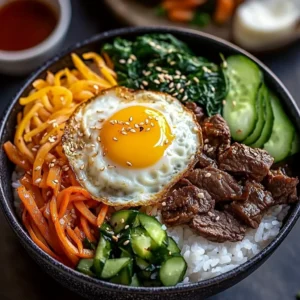
Korean Bibimbap
Bibimbap is a classic Korean rice bowl topped with colorful vegetables, savory beef, a fried egg, and spicy gochujang sauce — a perfect harmony of flavors and textures.
Equipment
- Large skillet or wok
- Rice cooker or pot
- Mixing Bowls
Ingredients
Rice
- 3 cups cooked short-grain rice warm
Beef Marinade
- 8 oz beef sirloin thinly sliced
- 1 Tbsp soy sauce
- 1 tsp sugar
- 1 tsp sesame oil
- 1 clove garlic minced
Vegetable Toppings
- 1 cup bean sprouts blanched
- 1 cup spinach blanched and seasoned with sesame oil and salt
- 1 carrot julienned and lightly sautéed
- ½ zucchini julienned and sautéed
- 4 shiitake mushrooms sliced and sautéed
- 1 cucumber julienned (optional)
Other Toppings
- 4 fried eggs sunny side up
- 1 Tbsp sesame seeds for garnish
Gochujang Sauce
- 3 Tbsp gochujang (Korean red chili paste)
- 1 Tbsp sesame oil
- 1 Tbsp water
- 1 tsp sugar
- 1 tsp rice vinegar
Instructions
- In a bowl, mix soy sauce, sugar, sesame oil, and garlic. Add sliced beef and marinate for 15 minutes.
- In a skillet over medium-high heat, cook the marinated beef until browned and cooked through. Set aside.
- Prepare each vegetable separately by blanching or sautéing lightly with salt and a touch of sesame oil. Set aside in individual bowls.
- Mix gochujang sauce ingredients in a small bowl until smooth and set aside.
- To assemble, place a portion of rice into each bowl. Arrange beef and vegetables neatly on top.
- Top each bowl with a fried egg and sprinkle with sesame seeds. Serve with gochujang sauce on the side.
- To eat, mix everything together thoroughly with the sauce before enjoying.
Notes
For a vegetarian version, omit the beef and use tofu instead. Adjust the spice level of the gochujang sauce to your preference.